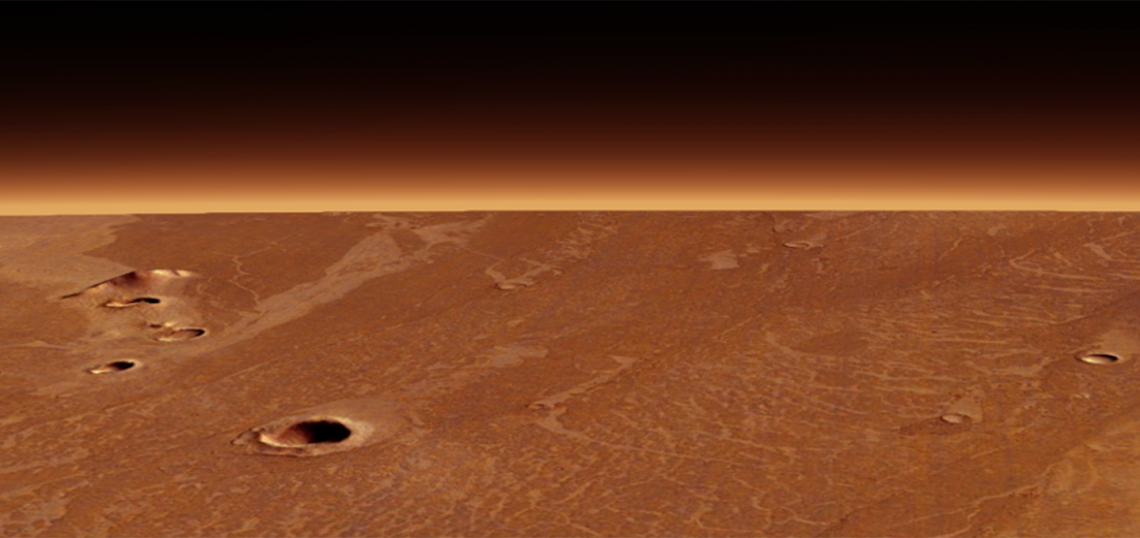
Planetary Volcanology
Constraining and Connecting Eruption Dynamics, Magmatic Processes, and Implications for Thermal Evolution of Planetary Bodies
Young Volcanic Terrains, Mars
Elysium Planitia is the youngest volcanic terrain on Mars and the only region that shows endogenic activity today. The InSight mission detected ~1,300 seismic events with the majority of them located in Elysium Planitia. The seismicity is consistent with melt migration in the subsurface. This makes Elysium Planitia a region of outstanding interest. Additionally, it shows evidence of multiple periods of small-scale lava shields and voluminous flood basalts that might have interacted with water and generated habitable hydrothermal environments. My research connected the surface with subsurface mapping and allows me to determine the areas, volumes, and timing of these recent volcanic and aqueous events to reconstruct their evolution (Voigt and Hamilton 2018; Voigt et al., 2023).
Amazonis Planitia contains one of the youngest terrains on Mars and is located in between the two major volcanic provinces, Tharsis to the east and Elysium to the west. It experienced high volume lava flow emplacement, flood basalts, as well as catastrophic aqueous activity. We just got two MDAPs funded to reconstruct Amazonis Planitia’s young history. Stay tuned, more to come soon.
Cryovolcanism, Europa
Europa, one of Jupiter's moons, has a subsurface ocean beneath an icy shell. We explore the dynamics of small brine pockets within the ice, showing how they can migrate from colder to warmer regions (Steinbrügge & Voigt et al., 2020). This migration is facilitated even at temperatures below the freezing point of pure water due to the increase in salinity of the migrating brine. Our investigation of the Manannán impact crater on Europa provides insights into how brine migrated towards the crater’s center, leading to the formation of a central reservoir. As this central water pocket began to freeze, the resulting pressure increase likely triggered a cryovolcanic eruption, emplacing brine onto the surface and forming a distinct "spider" feature before the ice collapsed. By utilizing a digital terrain model (DTM) combined with surface mapping and modeling, we estimate the volume of erupted water and were able to estimate the salinity of Europa's ice shell and subsurface ocean.
Impact Melt, Moon
The morphologies and emplacement dynamics of impact melt flows may differ fundamentally from those of lava flows, primarily due to their initially high temperatures and low viscosities. These properties may promote the formation of thin veneers near crater rims and turbulent emplacement, characterized by significant external clast entrainment. We developed a new facies map of the Giordano Bruno impact crater on the Moon and integrated rheology data to refine models of impact melt flow emplacement (Lev et al., 2021). By estimating initial flow temperatures and thicknesses from these models and observed flow lengths, we constrained the cooling histories, emplacement dynamics, and durations of the flows. Our findings suggest that super-liquidus impact melts are not necessary to replicate the observed flow lengths in Giordano Bruno.
Relevant Publications
Revealing Elysium Planitia's Young Geologic History: Constraints on Lava Emplacement Styles, Areas, and Volumes
J. R. C. Voigt, C. W. Hamilton, G. Steinbrügge, M. Christoffersen, S. Nerozzi, L. Kerber, J. Holt, and L. M. Carter (2023)
Journal of Geophysical Research: Planets
Brine Migration and Impact‐Induced Cryovolcanism on Europa
G. Steinbrügge*, J.R.C. Voigt*, N. S. Wolfenbarger, C. W. Hamilton, K. M. Soderlund, D. A. Young, D. D. Blankenship, S. D. Vance, D. M. Schroeder (2020) ∗Co-first author/corresponding authors
Geophysical Research Letters
Investigating the Volcanic versus Aqueous Origin of the Surficial Deposits in Eastern Elysium Planitia, Mars
J. R. C. Voigt, and C. W. Hamilton (2018)
Icarus
Emplacement conditions of lunar impact melt flows
E. Lev, C. W. Hamilton, J. R. C. Voigt, A. C. Stadermann, Y. Zhan, and C. D. Neish (2021)
Icarus
Geology and Physical Properties Investigations by the InSight Lander
M. Golombek, M. Grott, G. Kargl, J. Andrade, J. Marshall, N. Warner, N. A. Teanby, H. E. Abarca, R. G. Deen, V. Ansan, E. Hauber, J. Voigt, R. Lichtenheldt, B. Knapmeyer-Endrun, A. Trebi-Ollennu, J. Singer, J. Maki, C. Schmelzbach, S. Kedar, D. Banfield, I. J. Daubar, D. Kipp, N. Muller, P. Lognonné, W. Folkner, S. Le Maistre, D. Mimoun, N. Murdoch, S. Piqueux, P. Delage, W. T. Pike, C. Charalambous, R. Lorenz, L. Fayon, S. Smrekar, A. Lucas, S. Rodriguez, P. Morgan, A. Spiga, T. Gudkova, Ö. Karatekin, M. Panning, R. Garcia, D. Giardini, U. Christensen, T. Nicollier, D. Sollberger, J. Robertsson, K. Ali, W. Kim, O. Khan, C. Sorice, P. Bailey, B. Kenda, M. Siegler, C. Vrettos, and W. B. Banerdt (2018)
Space Science Reviews
The 2014–2015 Holuhraun Lava Flow-Field in Iceland as an Analog Site for Young Volcanic Terrains on Mars.
J. R. C. Voigt, C. W. Hamilton, L. P. Keszthelyi, M. Varnam, S. M. Hibbard, and K. M. Stack
(in review)
American Astronomical Society Journals








